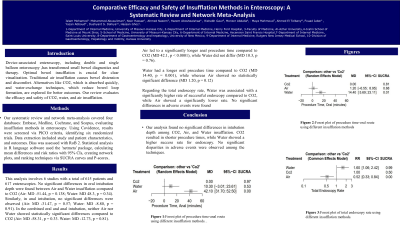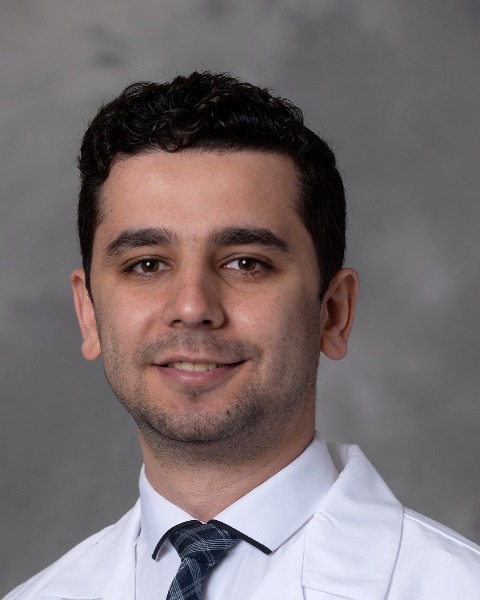Monday Poster Session
Category: General Endoscopy
P2378 - Comparative Efficacy and Safety of Insufflation Methods in Enteroscopy: A Systematic Review and Network Meta-Analysis
Monday, October 28, 2024
10:30 AM - 4:00 PM ET
Location: Exhibit Hall E

Has Audio

Mohammed Abusuliman, MD
Henry Ford Health
Detroit, MI
Presenting Author(s)
Islam Mohamed, MD1, Mohammed Abusuliman, MD2, Noor Hassan, MD3, Ahmed Naeem, MD4, Hazem Abosheaishaa, MD5, Rishabh Gaur, BA1, Monzer Abdalla, MD6, Maya Mahmoud, MD7, Ahmed El Telbany, MD, MPH8, Fouad Jaber, MD1, Yazan Abboud, MD9, Dushyant S. Dahiya, MD10, Hassan Ghoz, MD1
1University of Missouri - Kansas City School of Medicine, Kansas City, MO; 2Henry Ford Health, Detroit, MI; 3University of Missouri Kansas City School of Medicine, Kansas City, MO; 4Al-Azhar University, Cairo, Al Qahirah, Egypt; 5Icahn School of Medicine at Mount Sinai, Queens, NY; 6Ascension Saint Francis Hospital, Evanston, IL; 7SSM Health Saint Louis University Hospital, St. Louis, MO; 8University of New Mexico, Albuquerque, NM; 9Rutgers New Jersey Medical School, Newark, NJ; 10The University of Kansas School of Medicine, Kansas City, KS
Introduction: Device-associated enteroscopy, including double and single balloon enteroscopy ,has transformed small bowel diagnostics and therapy. Optimal bowel insufflation is crucial for clear visualization. Traditional air insufflation causes bowel distension and discomfort. Alternatives like CO2, which is absorbed quickly, and water-exchange techniques, which reduce bowel loop formation, are explored for better outcomes. Our review evaluates the efficacy and safety of CO2, water, and air insufflation.
Methods: Our systematic review and network meta-analysis covered four databases: Embase, Medline, Cochrane, and Scopus, evaluating insufflation methods in enteroscopy. Using Covidence, results were screened via PICO criteria, identifying six randomized trials. Data extraction included study and patient characteristics, and outcomes. Bias was assessed with RoB 2. Statistical analysis in R language software used the 'netmeta' package, calculating mean differences and risk ratios with 95% CIs, creating network plots, and ranking techniques via SUCRA curves and P-scores.
Results: This analysis involves 6 studies with a total of 615 patients and 617 enteroscopies. No significant differences in oral intubation depth were found between Air and Water insufflation compared to CO2 (Air: MD -51.44, p = 0.138; Water: MD 48.3, p = 0.34). Similarly, in anal intubation, no significant differences were observed (Air: MD -31.47, p = 0.57; Water: MD -8.80, p = 0.91). In the combined oral and anal intubation, neither Air nor Water showed statistically significant differences compared to CO2 (Air: MD -58.31, p = 0.33. Water: MD -12.73, p = 0.81).
Air led to a significantly longer anal procedure time compared to CO2 (MD 42.1, p < 0.0001), while Water did not differ (MD 10.3, p = 0.76).
Water had a longer oral procedure time compared to CO2 (MD 14.40, p = 0.001), while whereas Air showed no statistically significant difference (MD 1.20, p = 0.12)
Regarding the total endoscopy rate, Water was associated with a significantly higher rate of successful endoscopy compared to CO2, while Air showed a significantly lower rate. No significant differences in adverse events were found
Discussion: Our analysis found no significant differences in intubation depth among CO2, Air, and Water insufflation. CO2 resulted in shorter procedure times, while Water showed a higher success rate for endoscopy. No significant disparities in adverse events were observed among the techniques.
Disclosures:
Islam Mohamed, MD1, Mohammed Abusuliman, MD2, Noor Hassan, MD3, Ahmed Naeem, MD4, Hazem Abosheaishaa, MD5, Rishabh Gaur, BA1, Monzer Abdalla, MD6, Maya Mahmoud, MD7, Ahmed El Telbany, MD, MPH8, Fouad Jaber, MD1, Yazan Abboud, MD9, Dushyant S. Dahiya, MD10, Hassan Ghoz, MD1. P2378 - Comparative Efficacy and Safety of Insufflation Methods in Enteroscopy: A Systematic Review and Network Meta-Analysis, ACG 2024 Annual Scientific Meeting Abstracts. Philadelphia, PA: American College of Gastroenterology.
1University of Missouri - Kansas City School of Medicine, Kansas City, MO; 2Henry Ford Health, Detroit, MI; 3University of Missouri Kansas City School of Medicine, Kansas City, MO; 4Al-Azhar University, Cairo, Al Qahirah, Egypt; 5Icahn School of Medicine at Mount Sinai, Queens, NY; 6Ascension Saint Francis Hospital, Evanston, IL; 7SSM Health Saint Louis University Hospital, St. Louis, MO; 8University of New Mexico, Albuquerque, NM; 9Rutgers New Jersey Medical School, Newark, NJ; 10The University of Kansas School of Medicine, Kansas City, KS
Introduction: Device-associated enteroscopy, including double and single balloon enteroscopy ,has transformed small bowel diagnostics and therapy. Optimal bowel insufflation is crucial for clear visualization. Traditional air insufflation causes bowel distension and discomfort. Alternatives like CO2, which is absorbed quickly, and water-exchange techniques, which reduce bowel loop formation, are explored for better outcomes. Our review evaluates the efficacy and safety of CO2, water, and air insufflation.
Methods: Our systematic review and network meta-analysis covered four databases: Embase, Medline, Cochrane, and Scopus, evaluating insufflation methods in enteroscopy. Using Covidence, results were screened via PICO criteria, identifying six randomized trials. Data extraction included study and patient characteristics, and outcomes. Bias was assessed with RoB 2. Statistical analysis in R language software used the 'netmeta' package, calculating mean differences and risk ratios with 95% CIs, creating network plots, and ranking techniques via SUCRA curves and P-scores.
Results: This analysis involves 6 studies with a total of 615 patients and 617 enteroscopies. No significant differences in oral intubation depth were found between Air and Water insufflation compared to CO2 (Air: MD -51.44, p = 0.138; Water: MD 48.3, p = 0.34). Similarly, in anal intubation, no significant differences were observed (Air: MD -31.47, p = 0.57; Water: MD -8.80, p = 0.91). In the combined oral and anal intubation, neither Air nor Water showed statistically significant differences compared to CO2 (Air: MD -58.31, p = 0.33. Water: MD -12.73, p = 0.81).
Air led to a significantly longer anal procedure time compared to CO2 (MD 42.1, p < 0.0001), while Water did not differ (MD 10.3, p = 0.76).
Water had a longer oral procedure time compared to CO2 (MD 14.40, p = 0.001), while whereas Air showed no statistically significant difference (MD 1.20, p = 0.12)
Regarding the total endoscopy rate, Water was associated with a significantly higher rate of successful endoscopy compared to CO2, while Air showed a significantly lower rate. No significant differences in adverse events were found
Discussion: Our analysis found no significant differences in intubation depth among CO2, Air, and Water insufflation. CO2 resulted in shorter procedure times, while Water showed a higher success rate for endoscopy. No significant disparities in adverse events were observed among the techniques.
Disclosures:
Islam Mohamed indicated no relevant financial relationships.
Mohammed Abusuliman indicated no relevant financial relationships.
Noor Hassan indicated no relevant financial relationships.
Ahmed Naeem indicated no relevant financial relationships.
Hazem Abosheaishaa indicated no relevant financial relationships.
Rishabh Gaur indicated no relevant financial relationships.
Monzer Abdalla indicated no relevant financial relationships.
Maya Mahmoud indicated no relevant financial relationships.
Ahmed El Telbany indicated no relevant financial relationships.
Fouad Jaber indicated no relevant financial relationships.
Yazan Abboud indicated no relevant financial relationships.
Dushyant Dahiya indicated no relevant financial relationships.
Hassan Ghoz indicated no relevant financial relationships.
Islam Mohamed, MD1, Mohammed Abusuliman, MD2, Noor Hassan, MD3, Ahmed Naeem, MD4, Hazem Abosheaishaa, MD5, Rishabh Gaur, BA1, Monzer Abdalla, MD6, Maya Mahmoud, MD7, Ahmed El Telbany, MD, MPH8, Fouad Jaber, MD1, Yazan Abboud, MD9, Dushyant S. Dahiya, MD10, Hassan Ghoz, MD1. P2378 - Comparative Efficacy and Safety of Insufflation Methods in Enteroscopy: A Systematic Review and Network Meta-Analysis, ACG 2024 Annual Scientific Meeting Abstracts. Philadelphia, PA: American College of Gastroenterology.
